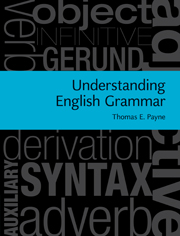Book contents
- Frontmatter
- Contents
- List of figures
- List of tables
- Preface
- Acknowledgements
- List of typographical conventions and abbreviations
- Introduction
- 1 History
- 2 Typology
- 3 The lexicon
- 4 Morphology – the shapes of words
- 5 Participant reference
- 6 Actions, states, and processes
- 7 Basic concepts in English syntax
- 8 Advanced concepts in English syntax
- 9 Complementation
- 10 Modification
- 11 Auxiliaries and the “black hole” of English syntax
- 12 Time and reality
- 13 Voice and valence
- 14 Clause combining
- 15 Pragmatic grounding and pragmatically marked constructions
- Glossary
- Endnotes
- References
- Index
11 - Auxiliaries and the “black hole” of English syntax
Published online by Cambridge University Press: 05 June 2012
- Frontmatter
- Contents
- List of figures
- List of tables
- Preface
- Acknowledgements
- List of typographical conventions and abbreviations
- Introduction
- 1 History
- 2 Typology
- 3 The lexicon
- 4 Morphology – the shapes of words
- 5 Participant reference
- 6 Actions, states, and processes
- 7 Basic concepts in English syntax
- 8 Advanced concepts in English syntax
- 9 Complementation
- 10 Modification
- 11 Auxiliaries and the “black hole” of English syntax
- 12 Time and reality
- 13 Voice and valence
- 14 Clause combining
- 15 Pragmatic grounding and pragmatically marked constructions
- Glossary
- Endnotes
- References
- Index
Summary
“Anything that crosses the boundary of a black hole cannot get back. Things can go in, but nothing can get out. Is that clear!” “Yes, Uncle,” she said. “I shall remember.”
from Black Holes and Uncle Albert (Stannard 2005:115)At several points in this book I have mentioned the importance of auxiliaries in understanding English grammar. In Chapter 3 we discussed the distinction (really a continuum) between grammatical functors and lexical vocabulary, and I argued that auxiliaries are grammatical functors, quite distinct from lexical verbs. This is because auxiliaries have all the characteristics of grammatical functors, e.g., they form a relatively small, closed set and express very limited semantic features. Verbs, on the other hand, have all the properties of full lexical words; for example, they form an open class of words that tend to express rich (complex) semantic content.
In this chapter we will look at constructions that contain auxiliaries, and will see how the “Inflection position” right after the Subject and before the main Predicate of basic English clauses is metaphorically speaking a “black hole” that has the power to suck lexical verbs into itself and convert them into the grammatical functors that grammarians call auxiliaries.
Later in the chapter I will suggest on the basis of the formal and functional properties of constructions that contain auxiliaries two major revisions to a traditional approach to English grammar. These suggestions, if taken seriously, significantly simplify the tasks of teaching, learning, and understanding English grammar.
- Type
- Chapter
- Information
- Understanding English GrammarA Linguistic Introduction, pp. 253 - 278Publisher: Cambridge University PressPrint publication year: 2010



